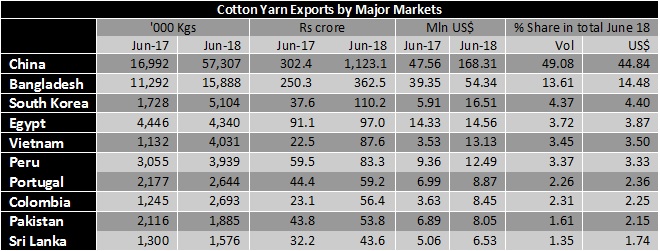Cotton yarn export surges, but weak Rupee brings down realisation
Cotton yarn export continued to remain robust on the low base in June this year. During the month, shipment was at 117 million kg worth US$375 million (INR2,500 crore), 75% above previous year’s level. They were imported by 81 countries at an average price of US$3.21 a kg, same as in previous month and slightly down US cent 1 from a year ago. In INR terms, the average price was INR214 a kg as against INR205 a kg in June 2017. With the currency weakening almost 5% during the year, realization in US$ term was down.

China continued doubling its import of cotton yarn from India in volume and value terms. It was followed by Bangladesh with volume and value both rising 40% over the year, and appear to be picking up. In May it had clocked a growth of just 15%. South Korea and Egypt were the other major importers, with former doubling their imports from India and latter slowing down considerably.
South Korea was the third largest destination. Five countries did not import any cotton yarn from India this June as they had imported yarn worth US$0.20 million last June. However, they were replaced by 15 other countries, which imported yarn worth US$2.49 million.
Vietnam, Bulgaria, Colombia and USA were among (other than top five) the fastest importers of cotton yarn in June while Paraguay, Denmark, Brazil, Slovenia and United Arab Emirates significantly reduced their imports compared to last year.
Nearly 60% of cotton yarn exported were knitting yarns while another 28% were weaving yarns. While China and Bangladesh were the major buyers of both kind of yarns, Peru, Egypt and Vietnam were the other major buyers of knit yarns. For weaving yarns, the other major buyers were South Korea, Pakistan and Italy.
About 63%of cotton yarn exported during June, were combed yarn, followed by 29% of carded and 5% of open ended yarns.
Grey yarns formed the majority of cotton yarn exported. 114 million kg of grey yarn was exported worth US$360 million.
Total spun yarns shipment was 142 million kg (up 73%) worth US$450 million (up 73%) implying an average unit value realization of US$3.16 per kg, slightly up by 2 cents compared to last year.